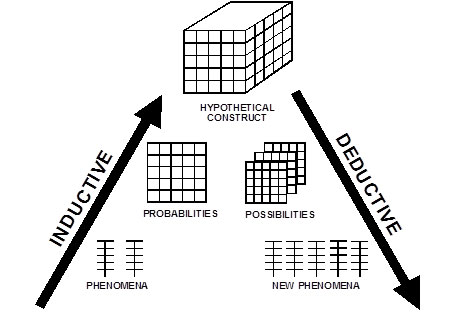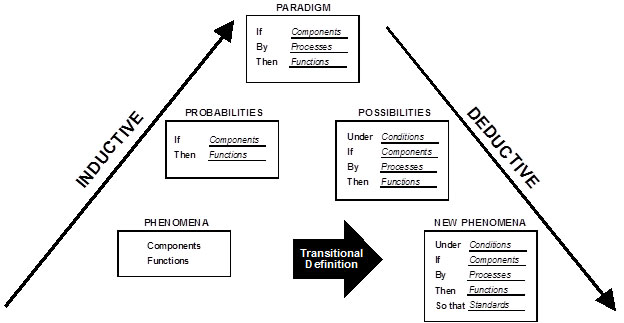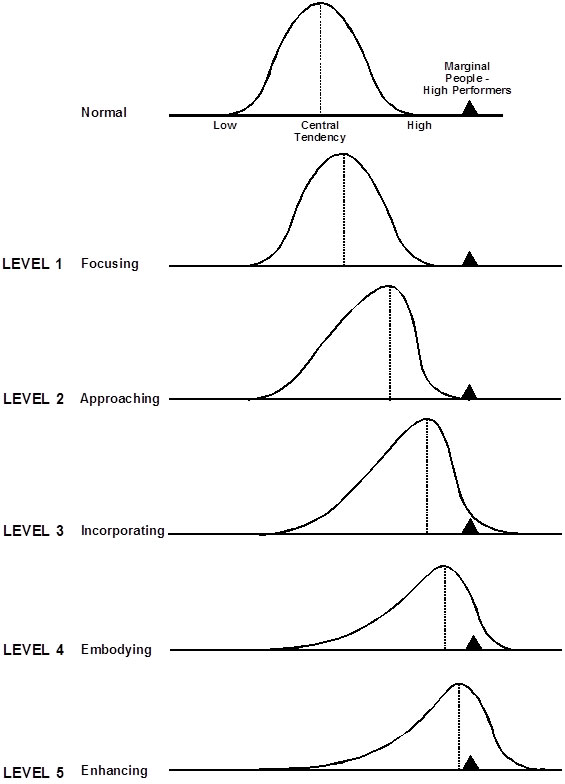Transforming Possibilistically*
As useful as the parametric distribution was for comparison of performance, it is also a powerful source of controlling performance. As we encountered human experiences and endeavors, we found The Probabilities Science limited in its abilities to describe and predict human performance, let alone to control it. Indeed, it was precisely the introduction of The Data Age that led to The Possibilities Science. All of the branching, parallel, and interactive processing systems of Information Technology or IT are based upon S–O–R Discriminative Learning Systems. They require extraordinary repertoires of conditioned responses with which the human organism (O) discriminates the stimuli (S) and emits the appropriate responses (R).
Possibilities Science is the source of changeability: process-centricity, the continuous processing of all phenomenal dimensions. As such, it expands 360 of global possibilities of continuously changing, interdependent, and asymmetrically curvilinear multidimensional phenomenal vectors. These phenomenal possibilities are due to the processing ability to align with the phenomena in their naturalistic form. In this context, probabilities phenomena occupy a small window of opportunity in space and time of the “Possibilities Universes” as “Probabilities Space-Times.”
The Possibilities Science addresses the limitations of The Probabilities Model. The critical difference between possibilities and probabilities is found in the quality of the dimensions and their interdependent relationships in continuously evolving processing systems. The operative words are “processing systems:” all dimensions are defined as processing systems. Specifically, the culminating function is to release or free the changeability in phenomena. This requires the highest level of phenomenal information; levels that enable us to relate and empower phenomena in order to release them.
_________________________
*Carkhuff, R. R. The Human Sciences. Amherst, MA: HRD Press, 2012.
| SCIENCES | FUNCTIONS | PROCESSING | MEASUREMENT |
|---|---|---|---|
| POSSIBILITIES |
|
S–O–R Discriminative Processing Systems |
Non-Parametric Measurement |
Ironically, it is with the introduction of Possibilities Science that The Normal Curve and Parametric Measurement come to life. Indeed, The Possibilities Scientist “anthropomorphizes” the phenomena being studied.
Possibilities Scientists bring the phenomena to life by aligning accurately with their external operations and then merging empathically with their internal operations. It is as if the scientist becomes “one” with the phenomenon.
Under the principles of Possibilities Science, “Hypothetical–Deductive Model-Building” is the source of this “Science of Change:” probabilistic models are built inductively and possibilistic hypotheses are derived deductively (see Figure 1):

Figure 1. The Building and Testing of Hypothetical Constructs
As may be viewed, hypothetical constructs are built inductively as follows:
- The observations of stable phenomena that are factored and scaled in related dimensions:
- The dimensions are formulated in “probabilities statements” (historically laws) that are related in operational systems and matrices:
- The probabilities dimensions are then related in hypothetical constructs (histori-cally theories) that are related multidimensionally in schematics and models:
In turn, the hypothetical constructs are the source of systematic deductive hypothesis testing:
- The “possibilities statements” are deduced from the hypothetical constructs occurring under differing phenomenal conditions (historically theorems) that are formulated as vectorial relationships:
- The hypotheses are deduced from the “possibilities statements” and tested empirically for achievement of standards under differing phenomenal conditions resulting in new phenomena:
This Hypothetical–Deductive Model-Building and Testing continues with the generation of new phenomena in replacement of the old phenomena: observations, probabilities, constructs, possibilities, hypotheses. Together, they culminate in the generation of “New Hypothetical–Deductive Model-Building and Testing.”
We may summarize our model-building with a “Verbal Articulation of Phenomena” (see Figure 2):

Figure 2. Verbal Articulation of Phenomena
As may be noted, the scientific models are built inductively and the technological hypotheses are derived deductively. This means that the models or paradigms are based upon inductive observations as “probabilities statements.” Concurrently, it means that the technologies are based upon deductive derivations as “possibilities statements.” As we will soon see, every application or transfer of a technology is a testable hypothesis.“The Best Idea” or “Exemplary Performance” is introduced by focusing upon its placement beyond “six sigmas” of the Probabilities Curve. It moves progressively through the operations of changeability that define “The New Possibilities Curve” (see Table 1):
Table 1. The Progressive Movement Toward Changeability
| Levels | Operations | ||||||||
|---|---|---|---|---|---|---|---|---|---|
| 5 | Enhancing | 4 | Embodying | 3 | Incorporating | 2 | Approaching | 1 | Focusing |
We may view the lifeful movement of the curve in Figure 3 on the following page. As the High Performer or “The Best Idea” attracts attention, the curve begins to move like a “hump-backed whale” toward higher performance.
The “Takeaway” from “Possibilities Science and Non-Parametric Measurement is the movement from the Controlling Function of Probabilities to the Releasing Function of Possibilities. It is the beginning of a joyous “Voyage of Discovery” toward Generativity which defines the “Best Processes for Generating the Best Ideas.”

Figure 3. The Progressive Movement of Transforming Possibilistically
